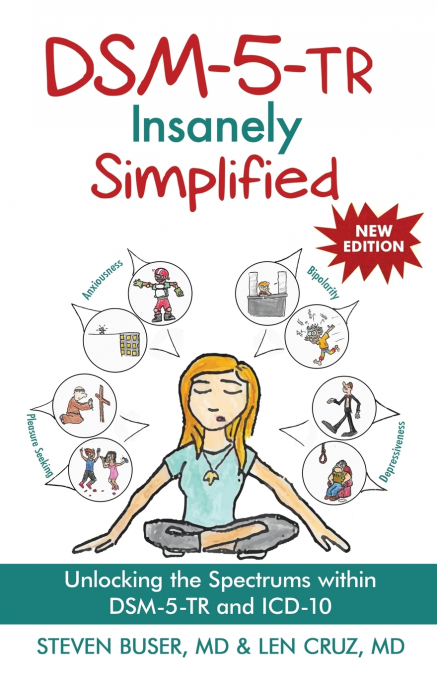
Leonard Cruz / Steven Buser
The publication of the Diagnostic and Statistical Manual Version 5® (DSM-5®, 2013) and the more recent Diagnostic and Statistical Manual Version 5 - Text Revision edition ® (DSM-5-TR®, 2022), together ushered in a major change to the field of mental health diagnosis. DSM-5-TR® Insanely Simplified provides a summary of key concepts of the new diagnostic schema introduced in DSM-5® and the updated DSM-5-TR® with a focus on the spectrum approach. It utilizes a variety of techniques to help clinicians master the new spectrum approach to diagnosis and its complex criteria. Cartoons, mnemonic devices, and summary tables allow clinicians and students to quickly grasp and retain broad concepts and subtle nuances related to psychiatric diagnosis. DSM-5-TR® Insanely Simplified fosters quick mastery of the most important concepts introduced in DSM-5® and continued in DSM-5-TR®, while offering an entirely new way of looking at mental health along a continuum. This new approach goes beyond simply 'labeling' clients with various diagnoses, but rather places them along spectrums that range from normal to problematic symptoms. Mental health professionals and laypeople will appreciate the synthesis of depth psychology and modern approaches to the diagnosis of mental illnessDisclaimerDSM-5-TR® and Diagnostic and Statistical Manual of Mental Disorders, Fifth Edition, Text Revision® are registered trademarks of the American Psychiatric Association (APA). This publication is independent of the American Psychiatric Association and has not been reviewed, endorsed, or approved by the APA.This book is not intended to serve as a substitute for the DSM-5-TR®. While it may discuss, reference, or interpret material found in the DSM-5-TR®, readers should consult the official publication of the American Psychiatric Association for authoritative information and diagnostic criteria. The DSM-5-TR® remains the definitive resource for the classification and diagnosis of mental disorders as established by the APA. Table of ContentsDSM-5-TR® Focused Review Pages Section I: Overview 1. Introduction2. History of Psychiatric Diagnosis3. What is new in DSM-5-TR®4. What was new in DSM-5®5. The 8 Primary Psychiatric Spectrums of Mental IllnessSection II: The 8 Primary Spectrums of Psychiatry 6. The Depression Spectrum: Shallowness vs. Despair7. The Mania Spectrum: Boring vs. Bipolar8. The Anxiety Spectrum: Carelessness vs. Anxiousness9. The Psychosis Spectrum: Visionless vs. Psychotic10. The Focus Spectrum: Attention Deficit Disorder vs. Obsessive Compulsive Disorders11. The Substance Abuse Spectrum: Ascetic vs. Addicted12. The Autism Spectrum: Codependent vs. Autistic13. The Personality Spectrum: Neurotic vs. ObnoxiousSection III: The Secondary Areas of Diagnosis 14. The Specialty Areas (Trauma, Neurodevelopmental, Neurocognitive, Behavioral, Dissociative, Somatic, Eating, Elimination, Sleep, Sexual, Gender, Paraphilia)Section IV: Conclusions 15. The Harmony of the Lotus Flower16. Carl Jung and his Relationship to DSM-5-TR®Appendix: On ICD-10 and the DSM-5-TR® Endnotes Index